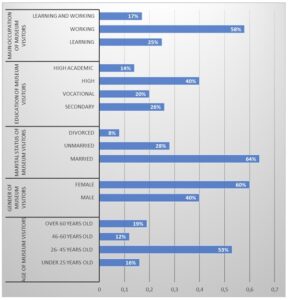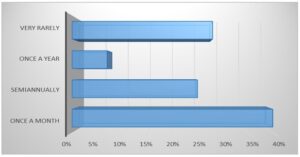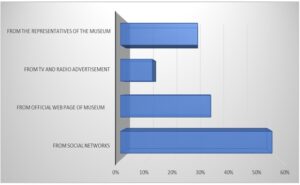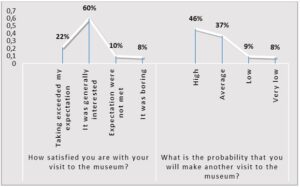This article deals with the analysis of various factors that impact the consumer behavior of museum visitors with an aim to build an effective marketing strategy that will help to expand the museum audience. The author proposes to divide them into two main categories: socio-demographic factors and factors of value orientations that form personal motives. The survey using questionnaire method was conducted in order to identify the importance of each category in the decision-making process. It showed the connection between frequency of the museum visits and family history of going to museums, as well as the fact that visitors are coming to the museum in order to satisfy some of their personal motives. Thus, the importance of value orientations that form personal motives was identified and its consideration when building a viable marketing strategy for museums was proposed.
1 Introduction
The growing competition in the cultural services market and the changing forms of consumer behavior necessitate the introduction and use of a marketing strategy that will help to expand the audience for such services. Over the past years, the organizations that provide services of a cultural and educational nature are changing; the very nature of consumption of culture is also changing. Thus, for example, in the United States, elitist consumption of culture is being replaced by the so-called „cultural omnivorousness“ (Peterson and Kern 1996). The terms „elitist consumption of culture“ and „cultural omnivorousness“ describe two different patterns of cultural consumption.
Elitist consumption of culture refers to a pattern of cultural consumption where individuals or groups selectively consume highbrow or elite cultural products, such as classical music, opera, or literary fiction, and view these cultural forms as superior to other cultural forms. In this context, culture is seen as a marker of social status, and those who consume elite cultural products are seen as more cultured or sophisticated than those who do not.
On the other hand, cultural omnivorousness refers to a pattern of cultural consumption where individuals or groups consume a wide variety of cultural products, spanning highbrow, middlebrow, and lowbrow forms. In this context, culture is not seen as a marker of social status, but rather as a way of exploring and experiencing different cultural perspectives and expressions. Those who exhibit cultural omnivorousness are seen as open-minded and inclusive in their cultural tastes. The museum, being an important element of culture, is also interested in the right marketing policy, which will enable it the active promotion of museum services and the expansion of its audience, on one hand, and, the implementation of its socio-cultural mission, on the other. In recent years, museum visitors are increasingly becoming consumers of museum services (Rodney 2015).
It is very important in this regard, that there is a clear understanding of the current and potential future museum visitors, their interests and expectations, as well as behavioral characteristics. The key here is finding the right balance between a search for a new and support from the existing museum audiences (Rentschler 2007). It is worth noting the significant shift in the museum’s focus from its exhibits to its audience (Jones and Mathé 2019). In this regard, the study of the consumer behavior of the museum audience becomes relevant.
The traditional five-step model of analyzing the purchasing decision process according to Kotler can be considered universal and can be used, among other things, in studying the consumer behavior of a museum audience: problem recognition, information search, evaluation of alternatives, purchase decision and post-purchase behavior (Kotler 2007). Each of the steps is very important for a marketer in terms of understanding their audience. At the same time, it should be noted that this model is not focused on some specific features of the consumer behavior of the museum audience, and is also mainly designed to study the behavioral patterns of consumers in the short term.
2 Literature review
The earliest and most significant study of the consumer behavior of museum audiences is Bourdieu’s work (1984). According to his research, visiting cultural organizations is directly related to the social status and level of education. At the same time, according to Falk (1998), demographic factors can no longer be considered sufficient to determine the behavioral characteristics of the museum audience. The Kotlers, on the other hand, believe that the cultural background is important in determining the motives for visiting a museum (Kotler et al. 2008). Housen (1987) proposes to consider three important parameters for determining the character of a museum visitor: demographic, specific attitude towards the museum, degree of education, and other factors associated with intellectual development. Hooper-Greenhill (2011) believes, that special attention should be paid to the diversified nature of the consumer behavior, since different people visit different museums and usually do so at different times. A substantial number of researchers also emphasize that visiting museums ceases to have only cultural and educational character and increasingly becomes more personalized and focused on obtaining experience and knowledge (Harrison 2013), while the very idea of such an undertaking becomes a key element in the context of communication between the museum and its audience. In this regard the direct participation of the visitors in various museum activities and the increase in the degree of their involvement in the museum work becomes important. (Simon 2010). Thus, John Falk and Lynn Dierking (2016) suggested to consider a range of factors that influence museum visitor expectations: previous experience, sources of information and types of museums. They also proposed the study of the process of knowledge acquisition in a museum within the following three categories:
1.Personal; 2. Social; 3. Physical. Each of these categories carries a number of motives for visiting the museum, and can be used to study the consumer behavior of the museum audience in order to expand it.
In the category of personal motives, one can add training and education, entertainment and experience, interests and curiosity, rest and recreation. The social motives for visiting the museum include those the end result of which is a social interaction aimed at strengthening family relations, acquiring new friends and the possibility of social communication. The category of physical motives includes comfort, attractiveness and uniqueness of the museum exposition.
John Falk (1998) singled out the main types of museum visitors, dividing them conditionally into five categories: Explorer, Facilitator, Experience Seeker, Professional/Hobbyist and Recharger. But at the same time, the issue of segmentation of the museum audience still remains complex and not fully resolved. It is complicated further by the change in the structure of consumer behavior of the museum audience and, as a result, the diversity of motives for visiting the museum.
The aim of this study is to consider a wide range of factors influencing the behavior of consumers of museum services, in particular the analysis of socio-demographic factors and various personal motives that directly impact the cultural activity of museum visitors.
3 Methodology of research
In this study, we used the method of reviewing the literature devoted to the research of the museum audience and the characteristics of its consumer behavior. As a result, two main groups of factors were identified: socio-demographic and value orientations that form personal motives, which, according to the author, form the basis of the museum audience’s consumer behavior.
In order to study the degree of influence of these two groups of factors on the consumer behavior, the questionnaire method was used. It was conducted between October 15 and November 15 among the visitors of the Bukhara State Museum, which is one of the most visited museums in Uzbekistan. The questionnaire consisted of 12 questions which included: demographic questions, closed-ended questions and Likert scale questions Another aim of this questionnaire was the determination of the social and cultural image of the modern museum visitor and identification of the main motives that encourage cultural activity of museum visitors.
In general, the survey was conducted for 30 days. 180 questionnaires were distributed, 167 of which can be considered suitable for processing and used in analysis of this study.
Descriptive statistics and correlation analysis were used to process the data obtained during the survey.
4 Analyses and results
The transformation that has taken place in the consumption of museum services indicates the importance of a two-way analysis of the factors influencing the consumer behavior of a museum visitor. Transformation in consumption of museum services refers to changes in the way that people engage with and use museum services. This could include changes in visitor demographics, the types of exhibits or programs offered by museums, or the ways in which visitors interact with exhibits or access museum content.
There are many factors that could contribute to transformations in museum consumption, including changes in technology, shifts in cultural attitudes and values, or changes in the social and economic landscape. For example, the rise of digital technologies has led to new opportunities for museums to engage with visitors online, while changing social attitudes may be leading to greater demand for more diverse and inclusive exhibits. To study transformations in museum consumption, researchers may use a range of methods, including surveys, focus groups, and observational studies. Statistical techniques such as regression analysis or time series analysis may also be used to examine trends and patterns in museum visitation or engagement over time. Overall, understanding transformations in museum consumption is important for museum professionals, policymakers, and researchers seeking to improve access to and engagement with museum services.
On the one hand, it is very important to assess the socio-demographic image of the museum visitor, and on the other hand, to assess the factors that have a direct impact on his cultural activity. Let’s consider them separately. We can attribute a number of socio-demographic factors such as social status, gender, place of residence, age, education, etc. to the socio-cultural image of a museum visitor. Within the framework of this study, it is important to trace the extent to which socio-demographic factors influence the manner and nature of the consumer behavior of the museum audience and whether they have a direct impact on the volume of consumption of museum services in general, as well as to form a general profile of the museum visitor. The factors that have a direct impact on the cultural activity of a person include value orientations – a number of personal motives and cultural characteristics of the environment in which a person grew up, guided by which the visitor makes a choice in favor of visiting a certain type of museum. A number of modern researchers believe that it is this series of motives that dominates the consumer behavior of the museum audience, which in turn means that socio-demographic factors fade into the background or do not at all impact the consumer’s choice of visiting the museum. In other words, visiting the museum today is not done with a goal to see something, it is more an action associated with the satisfaction of one’s personal motives.
4.1 Socio-demographic profile of a museum visitor
In the beginning, I propose to consider the socio-demographic profile of the museum visitor. The first five questions of the questionnaire were aimed at identifying precisely these characteristics (Figure 1).

Figure 1: Socio-demographic profile of museum visitors
Source: Author
This table shows that the main visitors to the museum are people aged between 26 and 45. The rest of the age categories are presented in relatively equal proportions. It should be noted that among the visitors to the museum, women predominate, making up to 60% of the respondents. It is also noteworthy that 58% of museum visitors are employed, so any advertising and PR in various organizations as a marketing communication tool for creating a permanent museum audience and attracting new visitors will have a more positive effect compared to, for example, advertising and PR in educational institutions. It can be added that most of the surveyed visitors are married and have a higher education. Based on these data, it can be said that the organization of any family events or events to strengthen family values in the museum will definitely be of a great success. Summing up, we can say that a museum visitor is a person aged between 26 and 45, is married, mostly has already received a higher education and is employed.
4.2 Value orientations that form personal motives
Turning to value orientations, it should be noted once again that here we are considering a number of factors that form the personal motives of museum visitors t should be noted the popularity of value-based marketing as a approach for communication with customers based on and about personal values and ethics (Strach 2018).
It is worth noting that 70% of the respondents answered that it was customary in their families to visit museums, which suggests that families with a tradition of visiting museums on a regular basis, develop a close relationship with the museum and subsequent generations also get accustomed to visiting such cultural organizations. Furthermore, 57% percent of visitors came to the museum with the purpose of education and cultural enlightenment, and 40% of respondents visit the museum because of their interest in permanent and temporary exhibitions. This is an indicator that the museum is still associated by consumers of cultural services with its main function of education and cultural awareness. In turn, such motives as just spending free time, going to the museum to show to children, visiting the museum while sightseeing and visiting the museum as a form of entertainment make up a small percentage. This indicates that the museum has not yet firmly established its position in the entertainment market and is losing competition to other places for entertainment that are more attractive from the point of view of consumers (Table 1).
| Personal motives for visiting the museum | Permanent exhibitions | Temporary exhibitions |
|---|---|---|
| Interest in the museum’s permanent exhibition | 40% | 37% |
| Education and cultural awareness | 57% | 48% |
| Desire to spend free time | 16% | 32% |
| Show the museum to kids | 11% | 13% |
| Went sightseeing | 13% | 8% |
| Entertainment | 7% | 9% |
Table 1: Main motives for visiting the museum
Source: Author
Furthermore, it is important to consider the frequency of the museum visits as an important factor when analyzing the value orientations that form the personal motives of the respondents (Figure 2). About 40% of respondents answered that they visit the museum every month. This group can be conditionally called a permanent museum audience. In this part of the audience there is not much hesitation when it comes to the decision to visit the museum. They are also very stable in terms of visiting the museum on a permanent basis. They seem to have already formed the habit of visiting the museum. For the goal of our research, however, from the point of view of expanding the museum audience, the remaining 60% percent, who visit the museum once every six months, once a year, or very rarely, are of greater interest. This points to the need for research on the correlation between visit frequency and museum visit motives. Although, we do not pose this issue within the framework of the current article.

Figure 2: Frequency of visit to the museum
Source: Author
When analyzing the behavioral characteristics of consumers of museum services, it is also important to consider the source of information from which the they prefer to receive information about museums and all sorts of cultural events (Figure 3). It should be noted that the leading position as a tool for communication between the museum and its audience has been assigned to social networks these days, which indicates that the museum should not only be presented in all social networks, but also actively promote its content through them. It is interesting to note that more than 30% of respondents prefer to follow the activities of the museum through the official web page. The third media is the promotion and advertising of the museum by its staff through the organization of meetings, visits, round tables and other events in various organizations, which indicates that sometimes direct personal communication with your potential audience is also beneficial.

Figure 3: The main sources for receiving information about museum
Source: Author
Summing up the survey, the following questions were asked: how satisfied are you with your visit? and how likely is it that you will make a repeat visit to the museum (Figure 4)?

Figure 4: Level of satisfaction and the likelihood of repeat visit to the museum
Source: Author
This graph shows a very positive ratio of satisfaction from the visit and the desire to revisit the museum among those surveyed. At the same time, 60% of those surveyed answered that it was generally an interesting visit, and only 46% expressed a high desire to revisit the museum again.
5 Conclusions
Having considered a wide range of factors influencing the consumer behavior of the museum audience, the author proposed a division of factors into two groups that is not universal, but greatly simplifies the task of research: Socio-demographic factors and factors of value orientations that form personal motives. Based on this division, a questionnaire was developed with the purpose of identification of the degree of influence of certain factors on the consumer behavior of the museum audience.
Based on the results of the survey, it is worth emphasizing that currently the main visitor of the Bukhara State Museum is a person aged between 26 and 45, married, mostly with a higher education and is employed. I would like to note that the study did not reveal a strong and close relationship between socio-demographic factors and the consumer behavior of the museum audience. It has also not been observed that a visitor with a particular socio-demographic profile tends to visit the museum more often. On the contrary, the author believes that with a properly built and directed marketing strategy, there is a high probability of a significant expansion of the museum audience and attracting people from different social groups to the museum.
Unlike socio-demographic factors, the factors of value orientations that form personal motives are of a more complex nature, which requires a deeper study of these factors and their influence on the consumer behavior of the museum audience. It is also worth noting the limitations of the study:
– Small sample sizes: Museum marketing research often relies on surveys, focus groups, and other methods that involve a relatively small sample size of visitors.
– Self-selection bias: Visitors who participate in museum marketing research may not be representative of the broader population of museum-goers, as they may be more motivated or interested in providing feedback than those who do not participate.
– Limited scope: Museum marketing research may focus on a specific aspect of the museum experience, such as exhibit design or program offerings, and may not capture the full range of factors that influence visitor behavior.
– Limited data availability: Museum marketing research may rely on data that is difficult or expensive to obtain, such as visitor traffic patterns or demographic information.
In the course of this study, a strong relationship was determined between the frequency of the museum visits and the existing family tradition of visiting the museums. Thus, 70% of the respondents confirmed that it was customary in their families to visit museums. Moreover, the idea that most of the museum visitors come to the museum not just to see something, but to satisfy their personal motives, among which education and cultural enlightenment prevail, found its confirmation in the survey.
In conclusion, we can say that the factors of value orientations that form personal motives have a serious impact on the consumer behavior of the museum audience. Henceforth, it is important for the museum to pay special attention to this factor when building a marketing strategy. Based on the statement that factors of value orientations form personal motives that have a serious impact on the consumer behavior of the museum audience, here are some recommendations:
– Conduct research to understand the value orientations and personal motives of the museum audience: In order to create exhibits and programs that resonate with visitors, it is important to first understand what drives their behavior. Conducting research through surveys, focus groups, and other methods can help identify the key value orientations and personal motives of the target audience.
– Tailor exhibits and programs to specific value orientations and personal motives: Once the value orientations and personal motives of the target audience have been identified, the museum can tailor its exhibits and programs to appeal to those specific interests. For example, if the target audience values education and intellectual stimulation, the museum can develop more educational exhibits and programs that provide in-depth information about historical or scientific topics.
– Communicate the value proposition of the museum: It is important for the museum to communicate its value proposition clearly to potential visitors. This can be done through marketing and advertising campaigns that highlight the unique features of the museum and its exhibits. By communicating the value proposition of the museum effectively, it can attract visitors who share the same value orientations and personal motives.
– Provide a variety of exhibits and programs: While it is important to tailor exhibits and programs to specific value orientations and personal motives, it is also important to provide a variety of exhibits and programs that appeal to a wide range of visitors. This can help attract a diverse audience and provide a more engaging and inclusive experience for all visitors.
– Continuously evaluate and adapt: The museum should continuously evaluate and adapt its exhibits and programs based on visitor feedback and changing value orientations and personal motives. This can help ensure that the museum remains relevant and engaging for its target audience over time.
Literatúra/List of References
- Bourdieu, P., 1984. Distinction: a social critique of the judgment of taste. Cambridge/Massachusetts: Harvard University Press, 1984. ISBN 0-674-21277-0.
- Falk, J. H. 1998. Visitors-who does, who doesn’t, and why (Why people go to museums). In: Museum News Journal. 1998, 77. ISSN 2578-7624.
- Falk, J. H. and Dierking, J. H.,2000. Learning from museums: Visitor experiences and the making of meaning. Rowman & Littlefield Publishers, 2000. ISBN 978-0742502956.
- Falk, J. H. and Dierking, L. D., 2016. The museum experience. New York: Routledge, 2016. ISBN 9781315417899.
- Jones, B. and Mathé, B., 2019. Consumerism & museums. 2019. [online]. [cit. 2023-01-20]. Available at: <https://miap.hosting.nyu.edu/program/student_work/2019spring/19s_3049_Jones_a3_y.pdf>
- Harrison, R., 2013. Heritage: critical approaches. London: Routledge, 2013, pp. 87-91. ISBN 978-0-415-59197-3.
- Hooper-Greenhill, E., 2011. Museums and their visitors. London: Routledge, 2011, pp. 143-168. ISBN 9780415513326.
- Housen, A., 1987. Three methods for understanding museum audiences. In: Museum Studies Journal. 1987. ISSN 2325-9337. [online]. [cit. 2023-01-20]. Available at: <https://vtshome.org/wp-content/uploads/2016/08/6-3MethodsforMuseumAudiences.pdf>
- Kotler, Ph., 2007. Marketing essentials. Prentice, 2007, pp. 655-657. ISBN 9780135572320.
- Kotler, N. G., Kotler, Ph. and Kotler, W. I., 2008. Museum strategy and marketing: Designing missions, building audiences, generating revenue and resources. Jossey-Bass, 2008, pp. 236-254. ISBN 9780787909123.
- Peterson, R. A. and Kern, R. M., 1996. Changing highbrow taste: From snob to omnivore. In: American Sociological Review. 1996, 61(5), 900-907. [online]. [cit. 2023-01-20]. Available at: <http://www.jstor.org/stable/2096460>
- Rodney, S., 2015. Museums, discourse, and visitors: the case of London’s Tate Modern. PhD thesis, Birkbeck: University of London, 2015. [online]. [cit. 2023-01-20]. Available at: <https://eprints.bbk.ac.uk/>
- Rentschler, R., 2007. Museum marketing: Understanding different types of audiences. Museum management and marketing. 2007. pp. 345-365. ISBN 9780080472058
- Simon, N., 2010. The participatory museum. Santa Cruz, CA: Museum 2.0. Medie Kultur. In: Journal of media and communication research. 2010, 27(50). ISSN 0900-9671.
- Strach, P., 2018. Value based marketing: Treating customers well to become better. In: Marketing Science & 2018, 13(4), 56-57. ISSN 1338-7944.
Kľúčové slová/Key words
museum, consumer behavior, museum marketing, museum audience, visitor profile, visitors’ motives, factors of influence
múzeum, spotrebiteľské správanie, marketing múzea, publikum múzea, profil návštevníka, motívy návštevníkov, faktory vplyvu
JEL klasifikácia/JEL Classification
M31, Z10
Résumé
Štúdia spotrebiteľského správania ako kľúč k rozšíreniu publika múzea
Tento príspevok sa zaoberá analýzou rôznych faktorov, ktoré ovplyvňujú spotrebiteľské správanie návštevníkov múzeí, s cieľom vytvoriť účinnú marketingovú stratégiu, ktorá pomôže rozšíriť publikum múzea. Autor ich navrhuje rozdeliť do dvoch hlavných kategórií: sociodemografické faktory a faktory hodnotových orientácií, ktoré formujú osobné motívy. Prieskum s využitím metódy dopytovania sa uskutočnil s cieľom identifikovať význam jednotlivých kategórií v rozhodovacom procese. Ukázala sa súvislosť medzi frekvenciou návštev múzeí a rodinnou históriou návštev múzeí, ako aj skutočnosť, že návštevníci prichádzajú do múzea s cieľom uspokojiť niektoré zo svojich osobných motívov. Takto sa identifikoval význam hodnotových orientácií, ktoré tvoria osobné motívy a navrhlo sa ich zohľadnenie pri budovaní životaschopnej marketingovej stratégie múzeí.
Recenzované/Reviewed
1. March 2023 / 15. March 2023












